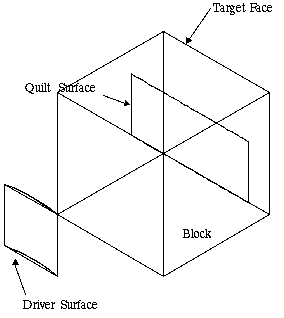Example
The following example program uses the quilt surface Open C API
routines. The intention of this program is to give you and idea of how
to set up the inputs and use the outputs from these routines. Thus, the
data used in this example is very simple and is not representative of
the capabilities of this function.
The flow of the code is as follows. First it creates the geometry
needed as input. It creates two arcs and then a ruled surface from the
arcs. Strings are set up for the primary and cross curves from the arcs
and two of the edges of the ruled surface. It then creates a b-surface
from the ruled surface since only b-surface types are allowed for the
driver surface of a quilt. Next, a block is created so that one of the
faces can be used as the target face.
Structures are set up to create a
UF_MODL_CURVE_MESH_ALONG_DRIVER_NORMALS type
quilt. UF_MODL_create_quilt is called to create the surface. Next
structures are set up to define a
UF_MODL_B_SURFACE_ALONG_FIXED_VECTOR type quilt.
UF_MODL_edit_quilt is called to update the quilt to the new type.
After this UF_MODL_ask_quilt_type is called to find out the type of
quilt surface we have (just to demonstrate the call). Then
UF_MODL_ask_quilt is called to retrieve the defining information of
the quilt. This information is modified slightly and
UF_MODL_edit_quilt is called again to update the quilt. Finally,
UF_MODL_free_quilt is called to free the memory allocated by
UF_MODL_ask_quilt.
The following is the output that is generated by the example program.

Figure Quilt Surface
#include <stdio.h>
#include <string.h>
#include <uf.h>
#include <uf_defs.h>
#include <uf_modl.h>
#include <uf_part.h>
#include <uf_curve.h>
#define UF_CALL(X) (report( __FILE__, __LINE__, #X, (X)))
static int report( char *file, int line, char *call, int irc)
{
if (irc)
{
char messg[133];
printf("%s, line %d: %s\n", file, line, call);
(UF_get_fail_message(irc, messg)) ?
printf(" returned a %d\n", irc) :
printf(" returned error %d: %s\n", irc, messg);
}
return(irc);
}
static void do_ugopen_api(void)
{
double block_origin[3]={0,1,0};
double tol[3]={0.1,0.1,0.1};
double distance_tol=0.01;
double angle_tol=0.5;
double pt1[3],pt2[3],pt3[3],value[6];
char *part_name="quilt";
char *block_length[3] = {"2","2","2"};
char project_limit[] = {"0.5"};
char inside_angle[] = {"90.0"};
char edge_angle[] = {"90.0"};
char inside_dist[] = {"0.01"};
char edge_dist[] = {"0.01"};
int units=2,err,tolerance_achieved;
int arc_mode=1;
int align=1,end_point=0,body_type=0;
tag_t part_tag,arc1_tag,arc2_tag,sheet_tag,face_tag,block_tag;
tag_t target_faces[1],quilt_tag,bsurface_tag;
UF_MODL_quilt_type_t quilt_type;
UF_STRING_t guide,spine,cross;
uf_list_p_t edge_list,face_list;
UF_MODL_quilt_data_structures_u
quilt_structure,ask_quilt_structure;
UF_MODL_curve_mesh_along_driver_normals_data_t quilt_data2;
UF_MODL_b_surface_along_fixed_vector_data_t
quilt_data3,*ask_ptr;
/* Open a new part */
UF_PART_new(part_name, units, &part_tag);
/* Create 2 arcs for guide strings for ruled surface */
pt1[0] = 0.0; pt1[1] = 0.0; pt1[2] = 0.0;
pt2[0] = 0.5; pt2[1] = 0.05; pt2[2] = 0.0;
pt3[0] = 1.0; pt3[1] = 0.0; pt3[2] = 0.0;
FTN(uf5063) (&arc_mode,pt1,pt2,pt3,&arc1_tag);
pt1[0] = 0.0; pt1[1] = 0.0; pt1[2] = 1.0;
pt2[0] = 0.5; pt2[1] = 0.05; pt2[2] = 1.0;
pt3[0] = 1.0; pt3[1] = 0.0; pt3[2] = 1.0;
FTN(uf5063) (&arc_mode,pt1,pt2,pt3,&arc2_tag);
UF_MODL_create_string_list(2,2,&guide);
guide.num = 2;
guide.string[0] = 1;
guide.dir[0] = 1;
guide.id[0] = arc1_tag;
guide.string[1] = 1;
guide.dir[1] = 1;
guide.id[1] = arc2_tag;
spine.num = 0;
/* Create ruled surface */
UF_MODL_create_ruled(&guide,
&spine,
&align,
value,
&end_point,
&body_type,
UF_NULLSIGN,
tol,
&sheet_tag);
/* Get the tag to the face */
UF_MODL_ask_body_faces(sheet_tag, &face_list);
UF_MODL_ask_list_item(face_list, 0, &face_tag);
UF_MODL_delete_list(&face_list);
/* Get the edges of the face */
UF_MODL_ask_face_edges(face_tag, &edge_list);
/* Set up a string for the cross curves. Find the two edges
opposite
the guide strings of the ruled surface to use as the cross
curves.
*/
UF_MODL_create_string_list(2,2,&cross);
cross.num = 2;
cross.string[0] = 1;
cross.dir[0] = 1;
UF_MODL_ask_list_item(edge_list, 1, &cross.id[0]);
cross.string[1] = 1;
cross.dir[1] = 1;
UF_MODL_ask_list_item(edge_list, 3, &cross.id[1]);
UF_MODL_delete_list(&edge_list);
/* Convert the ruled surface to a B-surface to be used as the
driver surface.
*/
FTN(uf5444)(&face_tag, &distance_tol, &angle_tol,
&bsurface_tag, &err);
/* Create a block */
UF_MODL_create_block1(UF_NULLSIGN, block_origin, block_length,
&block_tag);
/* Find the faces of the block. */
UF_MODL_ask_feat_faces(block_tag, &face_list);
/* Grab one of the faces to be used as the target face. */
UF_MODL_ask_list_item(face_list, 3, &target_faces[0]);
UF_MODL_delete_list(&face_list);
/* Set up the structures to define a quilt surface with a
driver type of Mesh of Curves. The projection type is
Along Driver Normals. Use the two guide curves as the
primary curves and two edge curves of the ruled surface as
the cross curves.
*/
quilt_type = UF_MODL_CURVE_MESH_ALONG_DRIVER_NORMALS;
quilt_data2.quilt_data.check_overlap =
UF_MODL_OVERLAP_CHECK_OFF;
quilt_data2.quilt_data.num_target_faces = 1;
quilt_data2.quilt_data.target_faces = target_faces;
quilt_data2.quilt_data.inside_distance = inside_dist;
quilt_data2.quilt_data.inside_angle = inside_angle;
quilt_data2.quilt_data.edge_distance = edge_dist;
quilt_data2.quilt_data.edge_angle = edge_angle;
quilt_data2.primary_curves = &guide;
quilt_data2.cross_curves = ✗
quilt_data2.projection_limit = project_limit;
quilt_structure.quilt_type2 = &quilt_data2;
/* Create the quilt surface */
UF_CALL(UF_MODL_create_quilt(quilt_type,
&quilt_structure,
&quilt_tag,
&tolerance_achieved));
UF_MODL_free_string_list(&guide);
UF_MODL_free_string_list(&cross);
/* Set up the structures to define a quilt surface with a
driver type of B Surface. The projection type is Along
Fixed Vector (+Y). Use the b-surface created from the ruled
surface as the driver surface.
*/
quilt_type = UF_MODL_B_SURFACE_ALONG_FIXED_VECTOR;
quilt_data3.quilt_data.check_overlap =
UF_MODL_OVERLAP_CHECK_OFF;
quilt_data3.quilt_data.num_target_faces = 1;
quilt_data3.quilt_data.target_faces = target_faces;
quilt_data3.quilt_data.inside_distance = inside_dist;
quilt_data3.quilt_data.inside_angle = inside_angle;
quilt_data3.quilt_data.edge_distance = edge_dist;
quilt_data3.quilt_data.edge_angle = edge_angle;
quilt_data3.driver_surface = bsurface_tag;
quilt_data3.projection_vector[0] = 0;
quilt_data3.projection_vector[1] = 1;
quilt_data3.projection_vector[2] = 0;
quilt_structure.quilt_type3 = &quilt_data3;
/* Edit the previously created quilt surface to have the new
definition.
*/
UF_CALL(UF_MODL_edit_quilt(quilt_type, &quilt_structure,
quilt_tag));
/* Find the type of quilt surface. */
UF_CALL(UF_MODL_ask_quilt_type(quilt_tag, &quilt_type));
/* Retrieve the quilt defining data. */
UF_CALL(UF_MODL_ask_quilt(quilt_tag, &quilt_type,
&ask_quilt_structure));
/* Modify the defining data slightly - increase the inside
distance tolerance from .01 to .05 and change the Y vector
component from 1 to .9. */
ask_ptr = ask_quilt_structure.quilt_type3;
strcpy(ask_ptr->quilt_data.inside_distance,"0.05");
ask_ptr->projection_vector[1] = 0.9;
/* Edit the quilt surface to have the new definition. */
UF_CALL(UF_MODL_edit_quilt(quilt_type, &ask_quilt_structure,
quilt_tag));
/* Free the memory allocated by UF_MODL_ask_quilt. */
UF_CALL(UF_MODL_free_quilt(quilt_type, &ask_quilt_structure));
}
/*ARGSUSED*/
void ufusr(char *param, int *retcode, int param_len)
{
if (!UF_CALL(UF_initialize()))
{
do_ugopen_api();
UF_CALL(UF_terminate());
}
}
int ufusr_ask_unload(void)
{
return (UF_UNLOAD_IMMEDIATELY);
}
